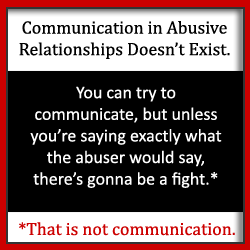Communication In Abusive Relationships Is A Myth
Communication in abusive relationships is like communicating with someone who cannot see or hear you and knows no word that describes the idea of someone who isn't me. When your abuser talks at you, they are talking to themselves.
Communication in abusive relationships is an all or nothing fight to the finish. Whether you're discussing the shade of towels for the guest bathroom or what elderly care facility Aunt Polly needs, the abuser expects you to say what s/he would say. Nothing more, nothing less, and definitely nothing different.
The only one who will ever attempt real communication in abusive relationships is you.
Communication in Abusive Relationships: In the Counseling Office
One time when Will, my ex, and I attended marriage counseling, the counselor gave us a little yellow magnet outlining the process of effective communication. The rules are simple:
- Person A (PA) describes what they think and feel about one topic.
- Person B (PB) paraphrases PA's statements to show they listened and understood. PA agrees (continue to step 3) or disagrees (back to step 1 to try again).
- PB responds with their own thoughts and feelings about the single topic and then PA paraphrases (as in step 2).
- Both people, staying on topic, continue taking turns speaking until they either reach an amicable solution or agree to disagree.
 The counselor asked Will and me to practice the four steps in front of her. I felt amazed at the outcome - I felt heard, valued and loved. Will and I reached an amicable agreement on one topic! This mode of communication and problem-solving saved my sanity. I felt valued and part of a team. Will said he felt satisfied, too.
The counselor asked Will and me to practice the four steps in front of her. I felt amazed at the outcome - I felt heard, valued and loved. Will and I reached an amicable agreement on one topic! This mode of communication and problem-solving saved my sanity. I felt valued and part of a team. Will said he felt satisfied, too.
But that was in the counselor's office.
On the walk out to the parking lot, Will stated, "One day we won't have to act like children in order to have a simple conversation." Funny . . . I felt that Will and I had just completed our first grown-up conversation in almost ever!
I wish that simple communication tool, small enough to fit on a refrigerator magnet, had worked with Will and me. Unfortunately, Will frisbee-tossed that little magic magnet at my head when I presented it to use at home. Sadly, I'd seen that coming from the walk from the counselor's office to the parking lot.
Communication In Abusive Relationships: Back At The House
Communication in abusive relationships will never go as smoothly at home as it does in the counselor's office. Abusers know how to play nicely front of other people, and sadly, many abusers do know a proper way to communicate. If they didn't know how to communicate well, they couldn't convince the neighborhood of their saintliness.
Will seemed to have an extremely different take on effective communication at home. If he wrote out his communication method on a magnet, it would have to be a big magnet. Will's method of communication goes something like this:
1.) Person A (PA) senses something he doesn't like. He twists it into a story to explain why Person B's (PB) is trying to cause him discomfort. PA never creates a nice story, always an ugly one, so PA becomes angrier and angrier. He gets louder (or more withdrawn) and watches PB closely for PB's reaction. When PB appears to be walking on eggshells, exhibits either cowering fear or an upset/angry face, PA continues to step 2.
2.) PA confronts PB about her current behavior. The confrontation begins with a statement like, "You're such a manipulative bitch!" or "I don't know why you're acting so weird - you're the one who's wrong!" or "I can't stand it when you get pissed about a problem you caused!"
3.) PB gets a brief period to respond. Inside, PB may bethinking "Here we go again..." with dread. Outwardly, PB may respond "What are you talking about?" or "I don't know what I did!" or "Me?! You're the one slamming cupboards and mumbling to yourself!" The thing is, it doesn't matter at all what PB says or does at this point. As soon as PA engages, he continues to step 4.
4.) PA tells PB what she did and why she did it. PA may use name-calling, anger, distraction, or any number of abusive tactics to derail PB's input because PB is trying desperately to solve the crisis. But PA does not care what PB says until PB agrees completely with PA's interpretation of events.
5.) PA feels right (and righteously angry) because he already knows what happened and why (see twisting the story in step 1). PA believes PB is lying until she regurgitates his explanation word for word. (Grab your coffee. This step can take hours.)
6.) Finally, after PA believes he successfully convinced PB of her nefarious motives, the punishment phase begins. Because PA was right all along, he determines the solution to the problem and what PB must do to appease his hurt feelings and remedy his lack of trust in her.
Note: The punishment/solution phase may be the first time PB gets to hear exactly what the problem is that needs solving. The lecture (ranting and raving) up to this point is was about what a slimy ingrate PB has been. Once PB is browbeaten into submission (around stage 5 or 6), PB may be too confused, scared, or tired to disagree to PA's take on the problem let alone give a crap what the solution should be.
To PA, this is a successful communication. PA gets his way and weakens PB. There will be less resistance from PB the next time PA cooks up a good story in his head.
Successful Communication In Abusive Relationships
Successful communication in a healthy relationship occurs when two people take the time to understand what the other says and wants, and then either come to an agreement or agree to disagree and try again later.
Successful communication in an abusive relationship is a myth. No matter how much you yell over, cry, or repeat yourself to an abuser, he or she will not hear you until you say what he or she wants you to say. When someone desires dominance and control, the best way to reach that goal is to deny any alternative outcome. You cannot have communication in abusive relationships because it takes two to communicate. Your abuser only wants to make you weaker . . . and to win.
Even if winning is but getting you to go with their choice of towels to put in the guest bathroom.
Still in doubt that your partner is abusive? Try the techniques in How to Fight Fairly With Your Relationship Partner. If your partner is abusive, the techniques won't work consistently because the abuser can't dominate the conversation.
See Also:
- How To Argue With Your Abusive Spouse and Win
- Verbal Abuse Disguised As Love
- Language of Love Omitted From Abusive Relationships
- Verbal Abuse Is Not A Communication Problem
*Both women and men could be abusers or victims, so please do not take my pronoun choices as an implication that one gender abuses and the other is victimized.
APA Reference
Jo, K.
(2012, January 12). Communication In Abusive Relationships Is A Myth, HealthyPlace. Retrieved
on 2025, November 30 from https://www.healthyplace.com/blogs/verbalabuseinrelationships/2012/01/communication-101-for-abusers-no-win-win
Author: Kellie Jo Holly
Your style is unque iin comparison to other folpks I have read stuff from.
Thank you for posting when you've got the opportunity, Guess
I will just bookmark this page.
@Kellie - Thank you for your kind words, I have worked hard to be a strong willed/identity woman before marriage, marriage to a narcissist etc was like a daily battlefield/minefield (egg-shells) which only weakened me but he could not fully break me therefore he left. So I knew very early on I was in an abusive relationship but that doesn't minimise the damage caused or make it easier to leave. The healing process has its good days and bad days but the willingness & determination to return to my former strength keeps me going and motivates me to try to heal sooner.
Reading your website/articles & ur story I see a common theme, like an online support group, it feels like self-therapy when reading your journey and I wish others suffering all the best.
Anon, you're a wise person. Thank you for commenting today on the blog. I've enjoyed and agreed with your assessments! You've done a whole bunch of healing since you left, haven't you? Do you find that understanding the abuse better has helped you to move past it? Or do you still have good days/bad days?
After step 1 which can last between 1 day to 1 month in the PA (Abusers) Head. Abuse begins with PA asking PB "What's wrong with you?" "Why are you not smiling today?" / simply "you look sad" in step 2. Regardless of reply PA attacks. Stage 4 involves bringing up old & "solved/past" issues including any current ones. Stage 5 involves accusation, the reason step 1 actually started and punishment in the form of emotional withdrawal, silent treatment or "acting the victim" diverting the blame. Sometimes Stage 3/5 may involve PB (Victim)trying to fight back or having an emotional breakdown with tears while PA (Abuser) just silently looks on. Result he blames his self-diagnosis of victim "She's just a depressed, worthless wife".
